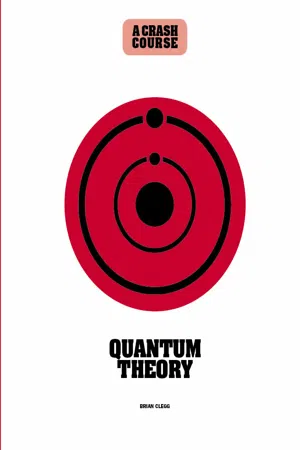1
FOUNDATIONS
“A theoretical interpretation had to be found at any price . . . I was prepared to sacrifice any of my previous physics convictions.”
MAX PLANCK LETTER OF PLANCK TO R. W. WOOD OCTOBER 7, 1931
THE DEATH OF VICTORIAN PHYSICS
By 1900, physics was a solidly Victorian affair. The foundations of physics came from the work of Galileo and Newton, which underwent small tweaks in the years that followed. However, the nineteenth century saw an explosion of developments that both expanded the discipline’s reach and took earlier ideas to dizzy new heights.
The importance of the steam engine to the industrial revolution meant that the science of thermodynamics came to the fore. Equally, electricity and magnetism, began to be understood in ways that enabled them to be put to practical use. The work of Scottish physicist James Clerk Maxwell brought light into the fold as an electromagnetic wave.
Two clouds
It is often said that by 1900 there was a smugness among physicists, who felt that only fine details remained to be sorted out. Specifically, the other great nineteenth-century Scottish physicist, William Thomson, also known as Lord Kelvin, is frequently quoted as saying “There is nothing new to be discovered in physics now. All that remains is more and more precise measurement.” There is no evidence that Kelvin ever said this, however. Perhaps the closest we have to the assertion came from Max Planck’s professor, Philipp von Jolly, when he suggested Planck study the piano rather than science as there was little left to do.
What Kelvin did say was that there were two clouds obscuring key aspects of physics. The first was the wave nature of light, which it was assumed required a medium, called the ether, in which the light could wave. But no experiment detected the ether’s presence. And the second cloud Kelvin called the “Maxwell–Boltzmann doctrine regarding the partition of energy.” This resulted in a phenomenon that became known as the “ultraviolet catastrophe.”
Between them, Kelvin’s clouds were the precursors of changes that transformed physics in the twentieth century. The first resulted in Einstein’s special theory of relativity, making Newton’s laws of motion a special case for relatively low speeds. The special theory itself then inspired Einstein’s general theory, transforming our understanding of gravity. Similarly, finding a solution to the second cloud resulted in the first move toward the development of quantum physics.
These twin giants—relativity and quantum theory—became the foundations of physics; practically all other aspects of the subject became influenced by them or subsumed into them. The reason, perhaps, that this transformation is not widely understood is that schools still teach a primarily Victorian physics curriculum. Although there is often an advantage in teaching subjects through historical processes, when there is such a significant transformation, it is very strange to ignore it. It seems likely that Victorian physics is preserved because relativity and quantum theory are considered “difficult.”
When we look at the period when Victorian physics was being displaced, it is not surprising that there was resistance at the time. Max Planck and Albert Einstein, both significant contributors to the origins of quantum physics, each had issues with it. Yet the successful idea that Planck used to fix the ultraviolet catastrophe and Einstein employed in an explanation of the photoelectric effect tore a hole in the understanding of the nature of light. It required light to be quantized—broken up into chunks or packets, rather than progressing as a continuous wave.
The cost of the quantum
Quantization itself was not an issue—it’s a common enough concept. For example, cash is quantized. There is no 0.513-cent coin. Physical currency has a quantum of 1 cent, and there is nothing smaller. Similarly, atoms quantized matter. The whole idea of an atom at the start of the twentieth century (which admittedly was incorrect) was that it was indivisible. The word “atom” comes from the Greek for “uncuttable.” So why did quantizing light produce a revolution in physics?
Initially, it was because of the move away from light being purely considered as a wave. But the aspects of quantum physics that disturbed Einstein—the introduction of probability as a fundamental aspect of nature, and the way that quantum physics made the act of measurement itself more significant than some underlying reality—were more likely causes for longer-term resistance. However, by the 1930s, only a few clung onto the past. All aspects of quantum theory may not be known or fully understood, but there is no doubt that physics itself was totally transformed by the work of the quantum physicists.
BIOGRAPHIES
MAX PLANCK (1858–1947)
Compared with the young radicals of quantum physics, Max Planck came from an older, stiffer generation. Born in Göttingen, Germany, in 1858, he remained solidly Victorian in his approach. When Planck was preparing for university, he could equally have chosen music or physics, as he excelled at both and was a concert-class pianist. Physics won out, though, and Planck was particularly drawn to the topics of heat and energy. From this came his attempt on the ultraviolet catastrophe.
Planck solved this mysterious behavior of matter by taking what he later described as a lucky guess, treating electromagnetic radiation as if it came in the form of packets of energy rather than continuous waves. This proved a great success, although Planck would never accept that it was anything more than a useful mathematical workaround. Although he won the Nobel Prize in 1918 for this work, he was never comfortable with quantum physics.
In later life, Planck was dogged by personal tragedy. The eldest of his three sons was killed in World War I, both his daughters died in childbirth, and his youngest son was caught up in a plot to assassinate Hitler and executed. Planck died two years later in ...

